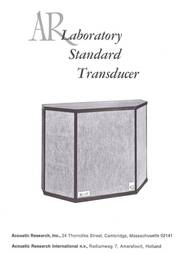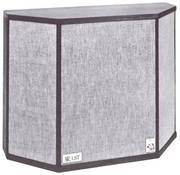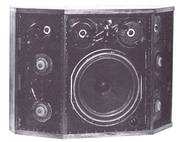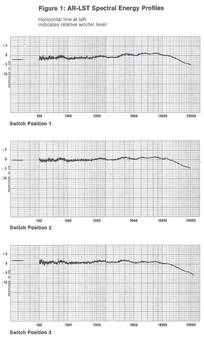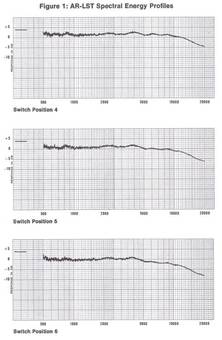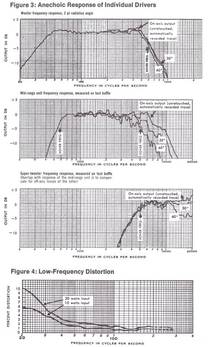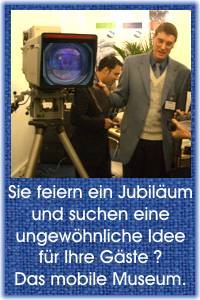Hier ein amerikanischer Prospekt der AR LST aus 1971
Selbstverständlich wird in einem Prospekt nur die Zucker- oder Sonnenseite des Produktes angepriesen. Selten werden Einschränkungen aufgeführt wie bei Arzneimitteln per Gesetz vorgegeben. Jetzt sind Lautsprecher nicht gerade lebensgefährlich, doch der Frust ist dann erheblich, wenn es einfach nicht klingen will.
Und das ist recht oft der Fall. Bei mir haben die LST nicht geklungen, die gingen zwar richtig laut und auch leise, aber sie machten keinen angenehmen Sound - sie haben nicht "geklungen". Das dort die gleichen Chassis wie in der berühmten AR 3a verbaut waren, wußte ich damals nicht.
Mit den diversen alten JBL Boxen der Ti Serie war es nahezu ebenso. Auf den JBL Seiten habe ich erläutert, wie lange es gedauert hatte, bis bei mir die Augen glänzten.
Der AR LST, das ist die Abkürzung für
"LABORATORY STANDARD TRANSDUCER"
The AR "Laboratory Standard Transducer" is designed for those laboratory and commercial applications that require conveniently repeatable, accurately known spectral energy profiles, including one flat profile extending from 30Hz to 20kHz.
The AR-LST uses a 12" acoustic suspension woofer, four 1 1/2" mid-range hemispherical radiators, and four 3/4" hemispherical tweeters. The individual speakers are identical with those of an AR-3a system. Crossover frequencies are 575 and 5,000 Hz.
Four mid-range speakers and four tweeters are included in the AR-LST to provide increased power-handling ability. Each of these combinations is wired in series/parallel.
The AR-LST contains an autotransformer with taps at 1db increments from 0 to -6db. Each of the speakers is connected (through its crossover filter) to one pole of a 3pole, 6position selector switch, which is fed by the autotransformer taps, so that the relative output levels can be adjusted as desired.
A large capacitor in series with the autotransformer prevents excessive amplifier loading at subaudible frequencies where the transformer's inductive reactance decreases.
Anmerkung 1 :
Die Verarbeitung unter der Abdeckung ist hundsmiserabel. Die Dinger sind wild zusammen geschustert und mit schwarzer Farbe und schwarzem Teer-Kleber wild angepinselt. Darum waren sie ja (über meine Quelle) auch so billig. Das war wieder so ein Mosaiksteinchen, daß ich alle ausländischen Fabrikate jetzt ganz besonders sorgfältig auf Preis-Leistung und Gegenwert hin beäugte.
Was ich damals auch nicht wußte, daß die Experten - wie die von Infnity und von Cabasse und auch der Mr. Walker von QUAD - herausgefunden hatten, daß man mit mehreren Hochtönern akustisch mehr kaputt macht als verbessert.
Also die 4 Hochtöner sind schon der erste akustische Sargnagel. Weiterhin haben die Akustiker am IRT und in den Labors herausgefunden, daß man die überlappenden Chassis - also zumindest Hoch- und Mitteltöner immer alle senkrecht übereinander oder untereinander montieren solle, damit die Phasenverschiebungen bei guten Stereo-Aufnahmen nicht vorkommen. Das alles hatte ich erst seit 2008 ausprobiert und es scheint zu stimmen. Das ist also der zweite akustische Sargnagel. Der Unterschied der BRAUN L710 zu anderen Boxen mit senkrecht angeordneten Chassis ist frappierend.
.
Der 6 Stufen-Drehschalter
Switch position No. 1 provides acoustic power response that rises slightly as frequency increases; the woofer output is 2 db lower than that of the tweeter.
Position No. 2 is the flat energy setting.
Positions 3 through 4 provide progressively greater slopes in energy response, with the level of low-frequency output increasing, relative to high-frequency output, by 2db for each higher numbered switch setting.
In positions 5 and 6 the balance of the AR-LST is approximately the same as that of an AR-3a with its level controls in the suggested "normal" settings.
Output level of the AR-LST mid-range units is held relatively constant for all of the six balance switch positions so that the overall impression of loudness does not change substantially as the switch position is changed.
.
Die Erläuterungenzu den Grafiken
Figure 1 shows typical 1/3-octave energy-output curves for each of the switch positions, from 500Hz through 20kHz. Below 500Hz the energy output is influenced by the acoustic environment; the woofer output into a 2 pi steradian anechoic environment is shown in Figure 3.
Because in this frequency range the system is completely nondirectional, the anechoic curve can be used to extend Figure 1 below 500 Hz when the AR-LST is placed with its back against the middle of a wall. The only differences will be those produced by variations in loading imposed by room reflections. Low-frequency output will be increased above that shown if the cabinet is placed in a corner; it will be decreased if the system is not close to a wall.
Figure 2 shows the impedance vs. frequency characteristics of the AR-LST for each of the six switch positions.
Figure 3 shows the anechoic response of the AR-LST's individual drivers.
Figure 4 shows the low-frequency distortion characteristics of the AR-LST.
Figure 5 is a schematic diagram of the AR-LST crossover network/ switching circuit.
Because the system impedance is increased by the autotransformer at middle frequencies relative to an AR-3a, the apparent efficiency of the AR-LST is lower if both systems are connected alternately to the same amplifier output terminals.
Anmerkung 2 :
Was sagen diese Grafiken wirklich aus ? Wo wurden die Kurven gemessen ? Kann man das auf den heimischen Wohnraum oder auf eine Theaterbühne oder auf den großen 600 Personen fassenden Audimax Saal der Universität Darmstadt übertragen ?
Im Prinzip nein, wie Georges Cabasse in seinem Büchlein ausführt und er hat es gemessen. Diese ganze Kurven sind absolute Makulatur und überhaupt nichts wert. Das gilt auch für CANTON und HECO und BRAUN und GRUNDIG und alle anderen.
Leider muß ich hier anfügen, ich bin damals um 1974 auch auf diese super tollen linearen Kurven herein gefallen. Es hatte ja funktioniert, das also war mein Traumlautsprecher. Aber großer Mist war es und die oder der LST hat es keine 2 Monate überlebt, denn meine Entäuschung und mein Frust waren riesig.
Dazu muß ich auch noch anfügen, daß das ganze Geschwafel mit der Effizienz und dem Wirkungsgrad auch nicht stimmte. Diese LST saugten meinen SONY STR 6120 aus wie zwei riesige Blutegel. Mit den 2 x 60 Watt Sinus war überhaupt kein Staat zumachen. Es wollte nicht klingen, auch mit den 2 x 190 Watt Sinus des Amcron DC300A nicht, auf dem Fußboden nicht, im Regal nicht, an der Wand nicht und vor der Wand auch nicht.
.
Über die Effizienz und den Wirkungsgrad
Actually there is no difference in real efficiency, but in order to get the same amount of audio power into an AR-LST at middle frequencies the voltage gain must be greater and the preamplifier volume control setting will have to be increased.
The amount of high-frequency power handled by the tweeters in an AR-LST, when its balance switch is set at low numbers, is substantially greater than for an AR-3a tweeter if the systems are played at the same loudness. Even though the total high-frequency power is divided among four tweeter units, it is necessary to exercise care to prevent excessive high-frequency energy output.
WARNING: A fuse block and fuses are provided with the AR-LST. Under no circumstances should the fuse terminals be bypassed. No fuse other than FNM 2 should be used with this system.
Replacement or repairs of speakers in the AR-LST system damaged by excessive power input are not covered by the guarantee.
Specifications
Sensitivity: 89.5 db SPL average, ±1db, with back against rigid wall.
Efficiency: 0.8% average, 2 pi radiation angle, ±1db.
Impedance: Depends on switch position; see Figure 2.
Frequency response, ±2db (eine völlig schwachsinnige Angabe)
Powerhandling ability with FNM 2 fuse:
180 watts for 10 seconds;
64 watts for 30 seconds;
23 watts long-term average.
Based on current into assumed nominal impedance of 4 ohms.
Speaker complement: 12" woofer, four 1 1/2" mid-range hemispherical radiators, four 3/4" hemispherical tweeters.
Phasing: Positive voltage applied to input terminal No. 2 causes woofer diaphragm to move forward (out of cabinet).
Cabinet size: overall: 68.9 by 50.8 by 24.8cm. - Weight: 90 pounds: 40.5 kg.
.
.

